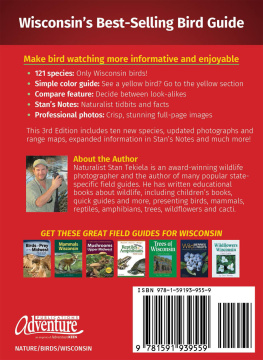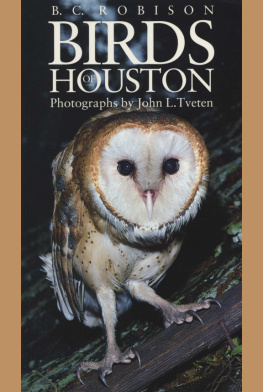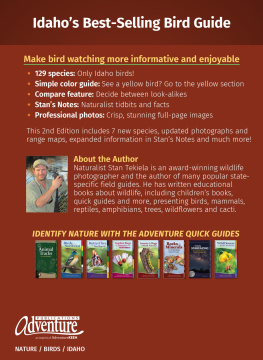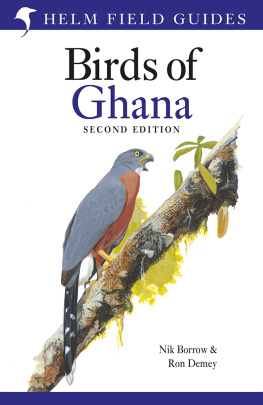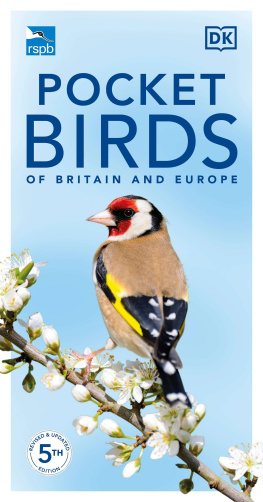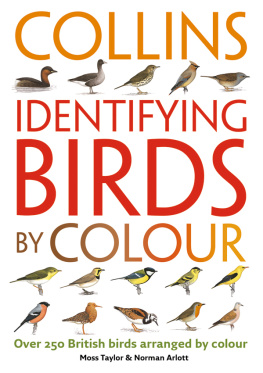A FIELD GUIDE
MARK W. LOCKWOOD
Photographs by Greg W. Lasley, Tim Cooper,
and Mark W. Lockwood
UNIVERSITY OF TEXAS PRESS
 Austin
AustinPublication of this book was aided by the generous support of the RGK Foundation, Mildred Wyatt-Wold, and the Corrie Herring Hooks Endowment.
Copyright 2007 by the University of Texas Press
All rights reserved
Second printing, 2014
Requests for permission
to reproduce material from this work
should be sent to:
Permissions
University of Texas Press
P.O. Box 7819
Austin, TX 78713-7819
utpress.utexas.edu/index.php/rp-form
LIBRARY OF CONGRESS CATALOGING-IN-PUBLICATION DATA
Library ebook ISBN: 978-0-292-75669-4
Individual ebook ISBN: 978-0-292-79318-7
DOI: 10.7560/713499
Lockwood, Mark.
Basic Texas birds : a field guide / Mark W. Lockwood; photographs by Greg W. Lasley, Tim Cooper, and Mark W. Lockwood. 1st ed.
p. cm. (Texas natural history guides)
Includes bibliographical references and index.
ISBN 978-0-292-71349-9 (pbk.: alk. paper)
1. BirdsTexasIdentification. I. Title.
QL684.T4L626 2007
598.09764dc22
| doi:10.7560/713499 | 2006035914 |
To my parents,
Robert and Sharon Lockwood,
for those nights at the kitchen table
and everything else.
CONTENTS
I thank Lorraine Atherton, Eric Carpenter, Richard Conner, Rob Fergus, and Cindy Lockwood for comments made on previous drafts. I would also like to thank Greg Lasley, Tim Cooper, and John Ingram for allowing the use of their many fantastic photos that illustrate this work. The maps found with each species are adaptations of those used in the TOS Handbook of Texas Birds (Lockwood and Freeman, 2004).
Texas has a large and varied birdlife, as diverse as the landscapes of the great state itself. Ecological diversity plays a major role in defining Texas birdlife, but other factors are also important. The states location in the southern latitudes and central longitude of the United States is one of the primary factors responsible for the wide range of species found here. These factors make Texas an excellent place to study birds, and almost anywhere in the state allows for a rewarding birdwatching experience. That is why Texas is now a destination for birders from all over the United States and even the world. This book is an introduction to some of the more common birds that might be encountered across the state.
The diversity of Texas can accommodate the full range of birding experience, from casual neighborhood observations to remote expeditions. Many people first become interested in birds simply by looking at the species that are attracted to their backyard. This often leads to exploring the parks or natural areas close to where they live. For some, their interest develops into a lifelong obsession. Birders in Texas can start a long spring vacation by watching migrants along the Coastal Prairies, then move on to the Lower Rio Grande Valley to have a peek at a more tropical birdlife before finishing up in the Hill Country or the Trans-Pecos. As the seasons change, so does the diversity of the birdlife. These changes offer new opportunities to study a different group of birds, even in the backyard or at a local park. Varying factors, such as weather and the available food crop, have a strong influence on bird distribution, which makes every year different. When looking at the entire state, this can have a profound influence on which species are present. For example, poor food crops in the Rocky Mountains can bring jays and finches into the western part of the state where they would be very rare or absent under normal circumstances. Severe freezes that extend well into northern Mexico have been known to cause that areas birds to disperse when the tender tropical habitats they occupy are damaged by the cold weather. Some of the birds end up in the Lower Rio Grande Valley. All of these factors add to the allure of Texas to birders. Truly dedicated birders who travel from region to region generally expect to observe more than 400 species within the state in a single year.
If this book, or the exploration of the birds of your yard or a nearby park, sparks the need for more information about the birdlife of Texas, many other books can be helpful. In particular, identification guides to the birds of the United States are quite useful. Two popular guides are the National Geographic Societys Field Guide to the Birds of North America (National Geographic Society, 2003) and The Sibley Guide to Birds (Sibley, 2000) or Sibleys supplementary guides that cover the eastern and western portions of North America (Sibley, 2003). In addition, the Texas Ornithological Societys TOS Handbook of Texas Birds (Lockwood and Freeman, 2004) takes a closer look at the status and distribution of birds of the state as a whole. Similar books examine specific regions, such as Birds of the Texas Hill Country (Lockwood, 2001), Birds of the Trans-Pecos (Peterson and Zimmer, 1998), Birds of the Texas Panhandle (Seyffert, 2001), and Birds of Northeast Texas (White, 2001), to name a few. These are not illustrated field guides but rather additional tools to help observers better understand what is known about the distribution and abundance of the birds of a particular region. The Texas Parks and Wildlife Department also produces regional checklists for most of the major ecological regions of the state. All of these resources are a great help in sorting out the diversity of Texas birds.
THE TEXAS LIST AND ITS NOMENCLATURE
Within the Lone Star state, 629 species of birds have been documented. The Texas Ornithological Society, through the Texas Bird Records Committee (TBRC), maintains the list of accepted species found in the state. This list increases by one to a few species most years. Most of these gains are the result of new discoveries that have been well documented; however, others are the result of taxonomic decisions by the American Ornithologists Union (AOU) through its Committee on Classification and Nomenclature. This group maintains the checklist of birds for North America and reviews scientific papers that provide data supporting reclassifications, either separating one species into more species or lumping two or more species into one. The taxonomic treatment and species sequence in this book follow the Check-list of North American Birds, Seventh Edition (AOU, 1998). Annual supplements to the check-list are published each July in The Auk, the quarterly journal of the AOU. The entire list of birds that have been accepted by the TBRC can be found in this book in the Appendix at the end of the species accounts.
For a species to be considered for inclusion on the Texas Ornithological Societys list, there must be a known specimen, a recognizable and confirmed photograph or video, or a recognizable and confirmed audio recording of that species from the state. When a species that is not on the Texas state list is discovered, documentation that meets one of those criteria must be obtained and reviewed to be accepted by the TBRC. More information about the TBRC and a list of species for which documentation is requested are available at http://texasbirds.org/tbrc/.
HOW TO USE THIS BOOK
The purpose of this book is to introduce the reader to the birds of Texas by looking at a cross section of commonly occurring species, some of which are likely to be encountered anywhere in the state. The book is an introductory tool that includes a broader spectrum of natural history information about each species than would be found in a typical field guide. When observing birds, however, a more inclusive field guide is needed to make comparisons of similar species and to have a wide range of illustrations of even common birds.




